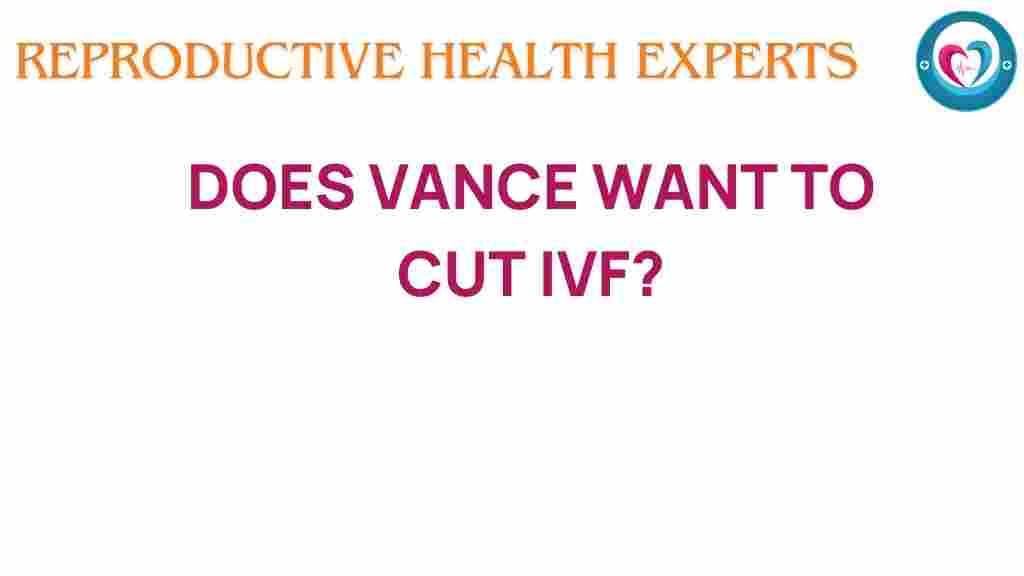Is Vance Planning to Cut IVF Funding? What You Need to Know
The landscape of reproductive health in Ohio is undergoing significant scrutiny, particularly regarding funding for in vitro fertilization (IVF). Recent discussions around healthcare policy and legislation have raised questions about whether Senator J.D. Vance is planning to cut IVF funding. Understanding the implications of these potential changes is crucial for those affected by fertility issues. This article delves into the current state of IVF funding, Vance’s position, and what it could mean for individuals seeking fertility treatments in Ohio.
The Current State of IVF Funding in Ohio
IVF funding has been a contentious issue in Ohio and across the United States. Many individuals and couples rely on IVF as a necessary means to conceive, but the costs associated with these treatments can be prohibitively high. Here are some key points to understand about the current state of IVF funding:
- Insurance Coverage: In Ohio, insurance coverage for IVF varies significantly. Some employers provide comprehensive coverage, while others do not cover any fertility treatments.
- State Initiatives: There have been initiatives aimed at increasing access to fertility treatments, but these often rely on government support and funding.
- Legislative Actions: Recent legislation has aimed to protect or expand funding for reproductive health services, including IVF, but political dynamics may pose challenges.
Understanding Vance’s Position
Senator J.D. Vance, a Republican from Ohio, has been a vocal figure in the discussions surrounding reproductive health and healthcare policy. His stance on various social issues has drawn attention and concern from advocates for reproductive rights. Here’s what you need to know about Vance’s position on IVF funding:
- Support for Family Values: Vance has positioned himself as a supporter of traditional family values, which may influence his views on reproductive health funding.
- Focus on Legislation: There is speculation that Vance may support legislation that redirects funding away from certain reproductive health services, including IVF.
- Public Statements: While Vance has made statements about the importance of family, his specific comments regarding IVF funding have been limited.
Potential Impacts of Cutting IVF Funding
If Vance or other lawmakers move to cut IVF funding, the implications could be significant for many individuals and families in Ohio. Here are some potential impacts to consider:
- Increased Financial Burden: Cutting funding could result in higher out-of-pocket expenses for individuals seeking IVF treatments, making it less accessible for many.
- Reduced Options: Fewer funding opportunities could lead to a decrease in available clinics and services, limiting options for patients.
- Impact on Family Planning: The ability to plan for families is crucial, and reduced funding could hinder many people’s ability to conceive.
Step-by-Step Process: How IVF Works
Understanding how IVF works can help individuals navigate their options in the face of changing funding policies. Here’s a brief overview of the IVF process:
- Consultation: The process begins with a consultation with a fertility specialist who evaluates the couple’s medical history and conducts necessary tests.
- Ovarian Stimulation: Hormonal medications are administered to stimulate the ovaries to produce multiple eggs.
- Egg Retrieval: Once the eggs are ready, a minor surgical procedure is performed to retrieve them from the ovaries.
- Sperm Collection: A sperm sample is collected from the male partner or a sperm donor.
- Fertilization: The eggs and sperm are combined in a laboratory setting for fertilization.
- Embryo Transfer: Once embryos are created, they are transferred into the woman’s uterus.
- Pregnancy Test: After a period of time, a pregnancy test is conducted to determine if the procedure was successful.
Troubleshooting Tips for IVF Patients
Navigating IVF can be challenging, especially in an uncertain funding environment. Here are some troubleshooting tips for IVF patients:
- Research Insurance Options: Check your insurance policy to understand what is covered and what isn’t regarding IVF treatments.
- Explore Grants and Financial Assistance: Look into organizations that offer grants or financial assistance for fertility treatments.
- Join Support Groups: Connecting with others who are going through similar experiences can provide emotional support and practical advice.
- Stay Informed: Keep up with news regarding healthcare policy and legislation in Ohio that could impact IVF funding.
Conclusion
The question of whether Vance is planning to cut IVF funding remains a critical issue for many individuals and couples in Ohio. As discussions around reproductive health and healthcare policy continue, it’s essential for those affected to stay informed and advocate for their needs. The future of IVF funding could significantly impact family planning options, making it crucial for residents to understand their rights and options.
For more information on reproductive health policies and IVF funding, you can visit this resource. Additionally, if you want to learn more about advocacy and support for fertility issues, check out this link.
As the situation evolves, staying engaged with local legislation and healthcare discussions is vital for ensuring access to necessary reproductive health services in Ohio.
This article is in the category Fertility and created by ReproductiveHealthExperts Team
